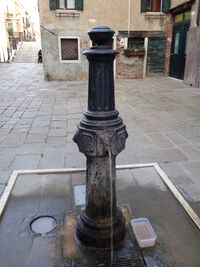Fountain: Difference between revisions
No edit summary |
Pierotoffolo (talk | contribs) No edit summary |
||
| (11 intermediate revisions by 2 users not shown) | |||
| Line 2: | Line 2: | ||
A fountain, ''fontana'', is a public drinking water system in Venice. It serves potable water to the public and locates all over the city. The majority of fountains run continuously whereas only a few of them have a push button to operate. Among the 142 fountains in Venice, only half of them are functional. The Venetian Fountain serves not only a practical purpose, but also as a unique aspect of Venetian vernacular art. see [[Public art preservation]] | A fountain, ''fontana'', is a public drinking water system in Venice. It serves potable water to the public and locates all over the city. The majority of fountains run continuously whereas only a few of them have a push button to operate. Among the 142 fountains in Venice, only half of them are functional. The Venetian Fountain serves not only a practical purpose, but also as a unique aspect of Venetian vernacular art. see [[Public art preservation]] | ||
[[File:A Venetian fountain.JPG|200px|thumb|right|A Venetian fountain]] | |||
| Line 9: | Line 10: | ||
==Types of Fountains== | ==Types of Fountains== | ||
In the Venetian Lagoon, there are multiple types of fountain according to their design and shape. These types include Delfini, Puglia, Alto, Ott. Basso, San Marco, Cylindro, Pozzo, Tubo, and Neri. Some of them have solid rectangular shape with some fancy designed lid at the top (i.e. Neri), while some of them are just a simple tube with a spout (i.e. Tubo). Additionally, these fountains have different faucet design with mostly lion heads. | |||
<gallery> | <gallery> | ||
File: | File:Fountain Types.png|Types of Fountain | ||
</gallery> | </gallery> | ||
==Material== | ==Material== | ||
The majority of the fountains in the Venetian Lagoon are metal and only a few of them are stone. Because of this, many fountains suffer from natural damage such as algae and especially rust. The location of Venice exacerbates this problem even more. The vast majority of the metal fountains are cast iron. These metal fountains are painted to cover the metal surface to avoid rust, but the paints wear out from times to times leaving the majority of metal fountains in the Lagoon susceptible to rust. Some stone fountains are made out of Istria stone and marble and typically built in a later period. | |||
<gallery> | <gallery> | ||
File: | File:Stone Fountain.JPG|Stone fountain with algae | ||
File:Metal fountain with rust and algae.JPG|Metal fountain with rust and algae | |||
</gallery> | </gallery> | ||
== | ==See also== | ||
*[[Fountains]] | |||
==References== | ==References== | ||
<references/> | <references/> | ||
==External Links== | ==External Links== | ||
[[Category: | [[Category:Fountains]] | ||
[[Category:Functional Artifacts]] | [[Category:Functional Artifacts]] | ||
[[Category:Public Art]] | [[Category:Public Art]] | ||
[[Category:Material Culture]] | [[Category:Material Culture]] | ||
Latest revision as of 13:25, 21 July 2015
This page contains information about a typical Venetian fountain.
A fountain, fontana, is a public drinking water system in Venice. It serves potable water to the public and locates all over the city. The majority of fountains run continuously whereas only a few of them have a push button to operate. Among the 142 fountains in Venice, only half of them are functional. The Venetian Fountain serves not only a practical purpose, but also as a unique aspect of Venetian vernacular art. see Public art preservation

History
A fountain, known locally as “fontana”, is the structure that dispenses public potable water in the City of Venice. An aqueduct system was completed from mainland in the late 1800's, which enabled a fountain system to emerge and to release a stream of safely potable water. These fountains usually locate in a “campo” or a street where they can be seen easily by the public. Some typical fountains were individually made with impressive design and some were mass-produced.
Types of Fountains
In the Venetian Lagoon, there are multiple types of fountain according to their design and shape. These types include Delfini, Puglia, Alto, Ott. Basso, San Marco, Cylindro, Pozzo, Tubo, and Neri. Some of them have solid rectangular shape with some fancy designed lid at the top (i.e. Neri), while some of them are just a simple tube with a spout (i.e. Tubo). Additionally, these fountains have different faucet design with mostly lion heads.
-
Types of Fountain
Material
The majority of the fountains in the Venetian Lagoon are metal and only a few of them are stone. Because of this, many fountains suffer from natural damage such as algae and especially rust. The location of Venice exacerbates this problem even more. The vast majority of the metal fountains are cast iron. These metal fountains are painted to cover the metal surface to avoid rust, but the paints wear out from times to times leaving the majority of metal fountains in the Lagoon susceptible to rust. Some stone fountains are made out of Istria stone and marble and typically built in a later period.
-
Stone fountain with algae
-
Metal fountain with rust and algae
See also
References


